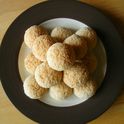I am continuing my question about fresh yeast from above.
The yeast I remember was in small cube in the refrigerated section of the grocery store. My local groceries do not carry this. Can I use dried yeast or should I look online for a source?
5 Comments
mcd2May 18, 2011
oops. hit a wrong key and sent the message before i'd edited it and finished writing. scratch that answer!
my understanding of yeasts is that any kind of yeast can be used in any recipe. active yeast comes in packets or cakes (a kind available before powdered yeast was available). instant or rapid rise yeast comes in packets also (marked as such). they are all usually sold at the same place on the grocery shelf. (sourdough is another leavening method but we'll focus on off the shelf yeast for this answer.)
the caviat though is that the METHOD of preparing the yeast differs and the amount has to be adjusted per the kind used. so once you know the conversions, any yeast can be substituted for any other in the equivalent amount & method to match a recipe. so if an old recipe, for instance, says x amount of cake yeast, the yeast used does not need to be cake yeast but an equivalent of the yeast you have on hand or available. or if a newer recipe specifies rapid rise yeast, slower yeasts can be used but they will rise more slowly & that has to be accounted for.
(an aside, rapid rise yeasts have only been on the market since the late 70's/early 80's. they were designed to shorten the rise times. back then, they were "proofed" in water like the older cake & powdered active yeasts. i quit baking about that time & lost track of the point at which rapid rise yeast started to be added to dry ingredients. maybe when dough hooks were an attachment to mixers!?)
anyway, although it seems confusing to understand all the terminology of this, the thing to remember is that yeast is yeast.
it's preparation and conversion that you need to be concerned about . there is a wonderful website called food subs or cooks thesaurus that is great for equivalents and substitutions of ingredients. look there to learn more about this subject (and how to use them interchangeably):
http://www.foodsubs.com...
i hope that helps with a little overview of why the different terms exist in different recipes & what to do about the confusion.
my understanding of yeasts is that any kind of yeast can be used in any recipe. active yeast comes in packets or cakes (a kind available before powdered yeast was available). instant or rapid rise yeast comes in packets also (marked as such). they are all usually sold at the same place on the grocery shelf. (sourdough is another leavening method but we'll focus on off the shelf yeast for this answer.)
the caviat though is that the METHOD of preparing the yeast differs and the amount has to be adjusted per the kind used. so once you know the conversions, any yeast can be substituted for any other in the equivalent amount & method to match a recipe. so if an old recipe, for instance, says x amount of cake yeast, the yeast used does not need to be cake yeast but an equivalent of the yeast you have on hand or available. or if a newer recipe specifies rapid rise yeast, slower yeasts can be used but they will rise more slowly & that has to be accounted for.
(an aside, rapid rise yeasts have only been on the market since the late 70's/early 80's. they were designed to shorten the rise times. back then, they were "proofed" in water like the older cake & powdered active yeasts. i quit baking about that time & lost track of the point at which rapid rise yeast started to be added to dry ingredients. maybe when dough hooks were an attachment to mixers!?)
anyway, although it seems confusing to understand all the terminology of this, the thing to remember is that yeast is yeast.
it's preparation and conversion that you need to be concerned about . there is a wonderful website called food subs or cooks thesaurus that is great for equivalents and substitutions of ingredients. look there to learn more about this subject (and how to use them interchangeably):
http://www.foodsubs.com...
i hope that helps with a little overview of why the different terms exist in different recipes & what to do about the confusion.
mcd2May 18, 2011
my understanding of yeasts is that any kind of yeast (active-powder or cake or instant) can be used in any recipe. the caviat though is that the METHOD of preparing the yeast differs and the amount has to be adjusted per the kind used.
pierinoFebruary 22, 2011
Fresh yeast, sometimes known as "brewers' yeast" has a fairly short life expectancy so unless you are baking bread every day as you might in a restaurant kitchen the home cook is probably fine with packets or jars of dried yeast. Of course making your own starters will yield a better flavor if you want to carry it that far...
beyondceleryFebruary 21, 2011
I actually followed ChefDaddy's recipe for English muffins yesterday and used dry yeast in the same quantity in place of the fresh. I made them gluten-free, so that caused another problem entirely, but the yeast part behaved exactly as it should have. I'd try the recipe just using dry yeast.
Sam1148February 21, 2011
I was in the same pickle last week. The recipe was weight based "no-kneed" bread.
Which was kinda fuzzy about the grams of fresh yeast--but suggested starting with 3 g.
http://blog.khymos.org/2010/12/22/no-knead-bread/#more-526
I went back to the original volume based recipe. And sub 1/4 tsp dry and a pinch more. (yes, fuzzy, I know). It came out very well.
Which was kinda fuzzy about the grams of fresh yeast--but suggested starting with 3 g.
http://blog.khymos.org/2010/12/22/no-knead-bread/#more-526
I went back to the original volume based recipe. And sub 1/4 tsp dry and a pinch more. (yes, fuzzy, I know). It came out very well.
Showing 5 out of 5 Comments
Recommended by Food52
Popular on Food52
Continue After Advertisement


